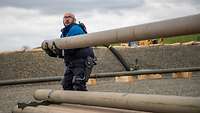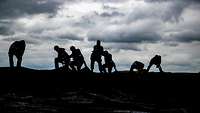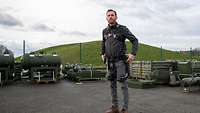The Air Defender 23 redeployment exercise will involve 24 nations with 220 aircraft. To refuel the aircraft, the Armed Forces Base (SKBStreitkräftebasis) with the Special Engineer Regiment 164 at the air base in Wunstorf, Lower Saxony, a field tank farm. Some of them are supported in this work by an exoskeleton.

In a pit almost the size of a tennis court on the edge of an airfield, six special pioneers get down on their knees. In front of them lies a folded thick tarpaulin. It is part of a field tank farm and weighs several hundred kilos. The sappers count to three together and begin unfolding the tarp. The soldiers can clearly see the effort they are making. Two pioneers wear an exoskeleton - a construction of straps, springs and poles - on their upper bodies during this back-breaking work. "An exoskeleton pulls the upper body back when lifting an object from a stooped position, thus relieving the lower back and the intervertebral discs there," explains Nico B. He is an engineer at the Fraunhofer Institute for Manufacturing Engineering and Automation. He has been conducting research in this area for five years. The research project is called "Use of exoskeletons in logistics of the armed forces base". The Future Development and Digitalization Unit at the Joint Forces Command is in charge of this project.
Special pioneers test exoskeletons
Here in Wunstorf, some special pioneers are testing prototypes of exoskeletons in work that specifically strains the back. Staff sergeant Marc H. is one of the testers and he is impressed by the effect of the construction: "The exoskeleton has helped me to spare my back. The strain is still there, but it definitely makes work easier." Lieutenant Uwe v.D. is an operations officer with Special Engineer Regiment 164 and thus responsible for the safety of the field tank farm construction in Wunstorf. He sees a clear difference in performance between the sappers who work with an exoskeleton and those who don't use the design. "At the end of the day, the soldiers who use an exoskeleton are significantly fresher," explains Lieutenant Uwe v.D. "What we also see, the grip on the back is significantly less frequent in those who have worn an exoskeleton for a longer period of time than in those who have not. "Change privacy settings
Exoskeletons in a combat situation
This research project by the Fraunhofer Institute and the SKB Armed Forces Base is not only investigating how exoskeletons can provide physical relief for soldiers in logistics. "It is important to investigate whether wearers can also get into and operate Bundeswehr vehicles without any problems," explains Major Jan R. from the logistics command of the SKBStreitkräftebasis. "We need to find out whether soldiers with exoskeletons can easily flow into a position when alerted or how quickly the device can be taken off when needed." That means wearers can quickly get to safety and defend themselves even in combat situations.
Exoskeletons in pipeline construction
Near the field tank farm in Wunstorf, pipes weighing a hundred kilos each are stacked. They have to be assembled into pipelines to supply the aircraft. A special engineer has to lift up to 30 such pipes a day and carry them to their destination. Again and again, you hear the command, "One, two, three - shoulder and go!" Two special engineers with exoskeletons carry pipe after pipe to the tank farms. One of them is corporal Dominik G. His experience with the exoskeletons: "For the activities we have here, it definitely helps. Especially for the lower back area, we have noticed a strong relief." Whether and which exoskeletons will be used in the logistics of the Armed Forces Base after the trial phase is to be determined at the end of the field trials. It still has to be determined whether commercially available exoskeletons or special designs are optimal for the needs of soldiers.


